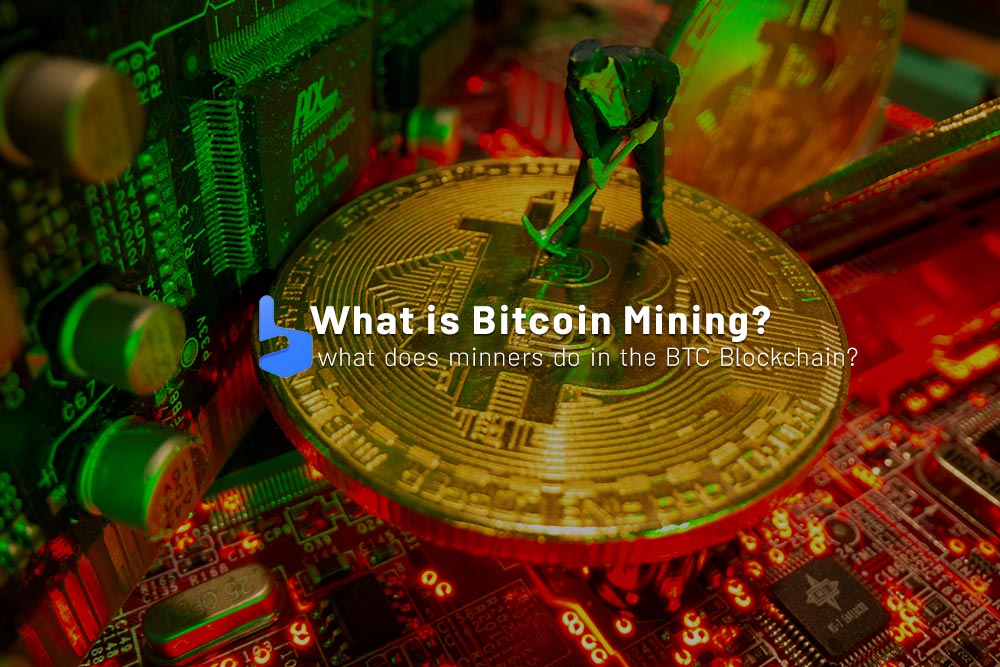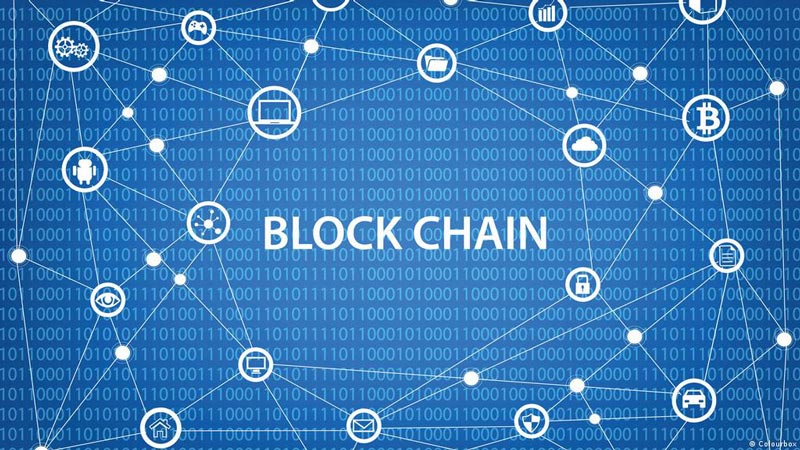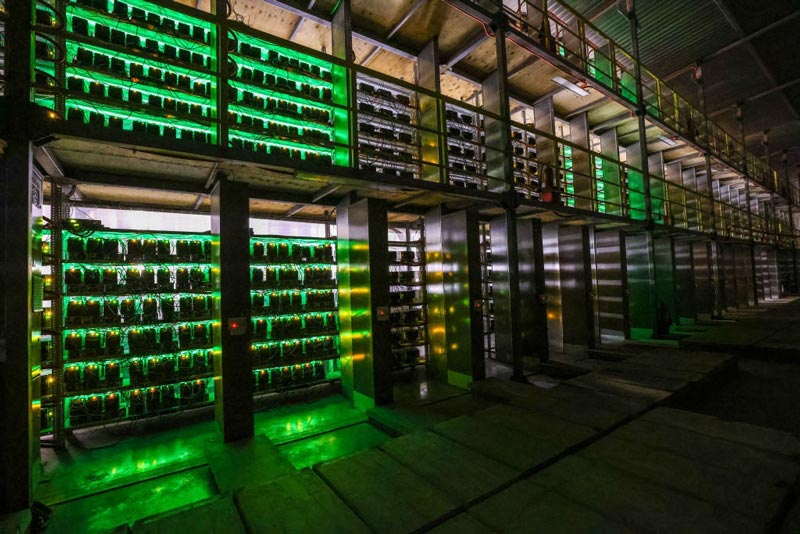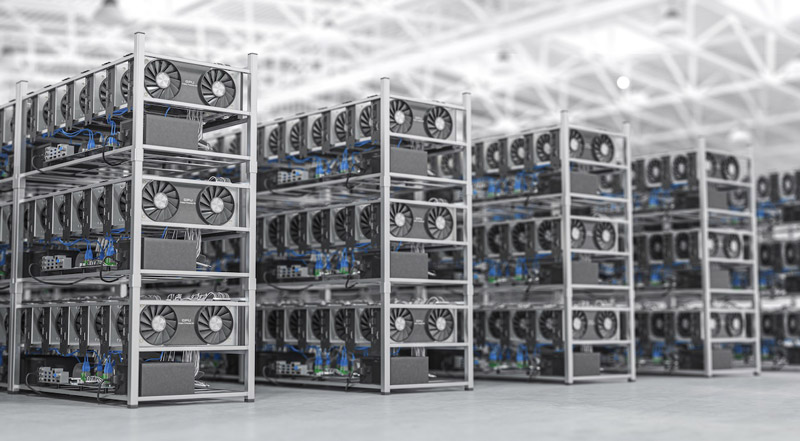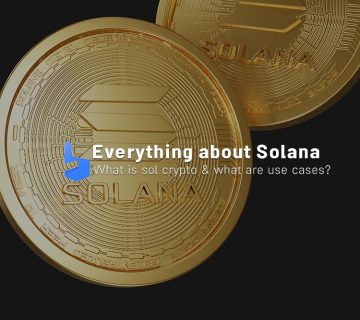What you are about to read:
Bitcoin mining essentially refers to the process of validating and adding new transactions to the Bitcoin blockchain while creating new bitcoins as a reward for miners’ efforts. In this article, Brokerland will thoroughly explain this process, which is an integral part of the decentralized nature of Bitcoin and is essential for maintaining the security and integrity of the network.
What is Bitcoin Mining?
Bitcoin operates on a distributed ledger called the blockchain, which is a public record of all transactions conducted with it. Miners play a crucial role in this system by confirming and grouping these transactions into blocks. They compete with each other by solving complex mathematical puzzles that require significant computational power.
Miners use specialized hardware such as high-speed processor computer systems to perform extensive calculations and solve these puzzles. This process requires substantial resources and a considerable amount of electricity. The goal of miners is to find a specific numerical value, known as a “hash,” which meets specific criteria set by the Bitcoin protocol. When a miner discovers a valid hash, they broadcast it to the network, and the block of transactions is added to the Bitcoin blockchain.
As a reward for their work and to incentivize participation, a certain number of newly created bitcoins are allocated to miners. This process is known as “block reward.” Initially, the block reward was set at 50 bitcoins per block. However, approximately every four years, this reward amount is halved.
Bitcoin mining pursues two primary objectives. First, it ensures the security and immutability of the blockchain through computationally expensive and economically infeasible calculations, making tampering or reversing transactions nearly impossible. Second, it regulates the issuance of new bitcoins, maintaining controlled and predictable supply over time.
It is crucial to note that with the evolution of the Bitcoin network, the mining process has become highly competitive, requiring significant investments in specialized hardware and energy. As a result, Bitcoin mining is predominantly carried out by large-scale entities often located in regions with access to cheap electricity.
What is Bitcoin Blockchain?
The Bitcoin blockchain is a decentralized public ledger that records all transactions made with this cryptocurrency. It serves as the foundation and backbone of the network, providing a transparent and immutable record of the details of each transaction.
Traditionally, financial transactions rely on centralized authorities such as banks for confirmation and record-keeping. In contrast, the blockchain operates on a peer-to-peer network, where multiple participants, known as nodes, collectively maintain the chain of blocks.
The blockchain consists of a series of blocks, each containing a set of confirmed Bitcoin transactions. These blocks are connected in chronological order, forming a chain-like structure. Each block has a unique identifier called a “hash” that represents the block’s data and acts as a digital fingerprint.
To ensure the security and integrity of the blockchain, the Bitcoin network uses a consensus mechanism called Proof of Work (PoW). As mentioned earlier, miners compete to solve complex mathematical puzzles to add a new block of transactions to the blockchain. When a miner successfully solves this puzzle, the new block is confirmed by other nodes and added to the blockchain.
A key feature of the Bitcoin blockchain is its decentralized nature. The blockchain is replicated and maintained across thousands of nodes worldwide. This decentralization makes it difficult for any single entity to control or manipulate the blockchain, ensuring transparency and security within the BTC network.
Transparency in the Bitcoin blockchain allows anyone to view all transactions that have ever occurred, but the identities of participants remain pseudonymous. Instead of using real names, transactions use encrypted addresses, essentially strings of characters generated randomly.
Is Bitcoin mining possible for everyone?
Technically, anyone with access to the necessary hardware and software can participate in Bitcoin mining. However, due to increasing difficulty and resource requirements, individual mining has become more challenging and less feasible over time.
In the early days of Bitcoin, mining could be efficiently done using ordinary computer CPUs (Central Processing Units). However, with the growth of the network and the number of miners, the difficulty of Bitcoin mining increased. Miners started using more powerful hardware, specifically Graphics Processing Units (GPUs), to achieve higher computational power and solve the complex mathematical puzzles required for mining.
With the popularity and price increase of Bitcoin, competition among miners intensified. This led to the development of specialized mining hardware called ASIC (Application-Specific Integrated Circuit). ASICs are designed solely for cryptocurrency mining and provide much higher computational power and energy efficiency compared to general-purpose hardware.
Currently, Bitcoin mining is primarily under the control of large-scale mining operations that have substantial investments in ASICs and access to cheap electricity. These operations can achieve cost savings on a large scale and outperform individual miners in terms of computational power, making the Bitcoin mining process more efficient.
While individual miners can still participate in Bitcoin mining, competition with specialized hardware and dedicated resources can be challenging for them. Additionally, costs associated with electricity, cooling, and maintenance can make Bitcoin mining unprofitable for individuals, especially in areas with high energy costs.
However, it’s crucial to note that Bitcoin mining is not the only way to participate in the ecosystem of this currency. Individuals can still buy and hold these coins through various exchanges or engage in other activities such as trading, investing, or using them for transactions without directly participating in the mining process.
Challenges of Mining
Now that we’re familiar with the concept of the blockchain and Bitcoin mining, it’s worth knowing that Bitcoin mining comes with challenges and issues, including:
Energy Consumption: Bitcoin mining is a computationally intensive process that requires significant energy consumption. As mining difficulty increases, miners need more powerful hardware, resulting in higher energy demand. This has raised environmental concerns, especially when relying on fossil fuel-based energy sources.
Centralization of Mining Power: Over time, mining has become increasingly centralized. Large-scale operations, often concentrated in regions with cheap electricity, have gained a significant share of Bitcoin mining power. This concentration raises concerns about the potential control of the network by a single entity or group, jeopardizing its decentralized nature.
High Costs and Specialized Equipment: Bitcoin mining requires specialized hardware like ASICs, and acquiring and maintaining them can be expensive. Additionally, costs related to electricity, cooling systems, and continuous upgrades can be substantial. These entry barriers and competition in the mining space pose challenges for small-scale miners.
Environmental Impact: The energy-intensive nature of Bitcoin mining contributes to its environmental impact. Since this operation consumes substantial amounts of electricity, mainly from non-renewable sources, the carbon footprint of Bitcoin mining raises concerns about sustainability and its contribution to climate change.
Network Congestion and Scalability: With the increasing number of transactions in the Bitcoin network, block size and block time become limiting factors. This can lead to network congestion and delays in transaction confirmations. Scalability solutions like the Lightning Network have been proposed to address these issues but are still in the early stages of adoption.
Geographic Concentration of Mining: Bitcoin mining tends to concentrate in regions with lower electricity costs, often due to renewable energy resources or abundant subsidies. This geographic concentration raises concerns about potential regulatory risks and vulnerability to local events or disruptions.
Excess Heat: BTC mining hardware generates a significant amount of heat during the extraction process. Managing and dissipating this excess heat can be a challenge, requiring additional infrastructure for cooling, which increases overall energy consumption and mining costs.
Efforts are underway to address some of these challenges, such as developing more efficient Bitcoin mining hardware, exploring renewable energy sources for mining operations, and implementing alternative consensus mechanisms to reduce energy consumption. However, these issues highlight the complexities and ongoing debates surrounding this process.
Summary
Bitcoin’s blockchain revolutionizes the way financial transactions are conducted by providing a secure, transparent, and decentralized system for recording and verifying transactions without the need for intermediaries. Bitcoin mining refers to the process of validating and recording transactions in this network.
The primary goals of Bitcoin mining are twofold: validating transactions to prevent fraud and adding new blocks to the blockchain, creating new bitcoins in a decentralized manner.
While technically anyone can mine Bitcoin, the increasing difficulty, the need for specialized hardware, and competition resulting from large-scale operations make it less feasible and profitable for individual miners compared to previous years.

